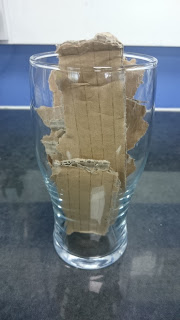With competition season well under way we thought it would be useful to make this week’s Weekly Mash all about off flavours. Even if you aren’t looking to enter competitions, being able to recognise and remedy (or even better, avoid altogether!) these common faults is an important part of becoming a great brewer.
Below we run through some of the most common faults, but there are some good general practices you can follow to ensure you always get the best from your beers first;
- Clean and sterilise everything! Cleanliness is one of the most important aspects of making good beer.
- Always use healthy yeast and enough of it. If you use liquid yeast make a good sized starter and if you use dried yeast make sure it’s well in date and rehydrated.
- Oxygenate your wort. Whether it’s a shake or a dedicated O2 tank, proper oxygenation makes the difference.
- Ferment at a suitable temperature for the yeast you are using.
Acetaldehyde – Most people pick up on this as the smell of fresh green apples. Acetaldehyde is actually produced during normal fermentation but is reabsorbed by the yeast. If it is present in your beer it is likely you took your beer off the yeast before it was able to be reabsorbed.
To avoid this in your beer ensure:
- Fermentation is vigorous and use healthy yeast,
- Allow full attenuation
- Leave beer on yeast longer
- Oxygenate wort fully
- Try another yeast strain
- Make sure sufficient yeast nutrients are available
- Let beer age longer.
Sour/Acidic – Normally this is a clear sign of an unwanted infection. If you’re making a sour beer then you are probably okay but otherwise, this is a fault. Look for lactic acid, citric acid or sharp, clean sourness. If this is present check for infection, check your yeast strain and don’t mash for long periods of time at low temperatures, as this is the perfect environment for acid producing bacteria.
Light-struck – Light struck refers to a beer that has been exposed to sunlight. This creates a reaction which coverts isomerised alpha acids into sulphur compounds leading to a skunky, catty aroma. Avoiding this can be quite simple, don’t expose wort/beer to sunlight after hops have been added. Don’t use clear or green glass bottles. Avoid use of cluster hops in late hop additions.
Solvent/Fusel – You will pick up on this as a burning sensation on the palate. This is most likely caused by yeast that has been stressed during fermentation, to avoid it:
- Lower your fermentation temperature
- Pitch a sufficient quantity of healthy, active yeast
- Check for infection
- Try a different yeast strain
Smoky (phenolic) – Sometimes desirable in a beer, this imparts a smoke-like, charcoal, burnt character. If you were not looking to create this:
- Check for a scorched mash or boil
- Check excessive use of dark malts
- Check for infection
Musty – Water chemistry and exposure to oxygen are important factors here. If you aren’t careful you can get stale, mouldy, cellar-like flavours.
- Avoid oxidation
- Check sanitation
- Avoid peat smoked malt
- Check water for freshness and taste
- Use fresh ingredients (especially malt and hops)
Oxidised – Once your yeast is pitched into your wort it becomes extremely important to minimise the amount of oxygen that your beer is exposed to, otherwise you risk your final product tasting stale, papery or of cardboard.
- Check for oxygen being introduced into beer post fermentation
- Don’t splash when racking/bottling
- Check caps and/or keg seals for good fit
- Purge bottles/kegs with CO2 prior to filling
- Store beer cold
- Drink beer when fresh
 |
| Oxidised |
Alcoholic/Hot – Often another sign of stressed yeast, this will result in spicy, vinous, warming characteristics from ethanol and higher alcohols. Like some of the others described here, it can be desirable in small amounts in some beers. To avoid this:
- Lower your fermentation temperature
- Use a less attenuative yeast strain
- Check yeast health
- Use less fermentables
- Use less sugary adjuncts
- Check for possible infection
- Raise mash temperature
- Let beer age longer before consuming
Estery – Yeasts produce esters as a normal fermentation byproduct. Esters can impart a fruity flavour which can be quite pleasant. If that’s not what you were after though you can try:
- A cleaner yeast strain
- Oxygenate wort sufficiently
- Reduce original gravity
- Check hop variety for fruity characteristics
- Avoid carrying over excessive break into fermenter
- Pitch a sufficient quantity of yeast
- Bottle condition and age beer longer at cellar temperatures to reduce esters
Grassy – If your beer has the taste of fresh cut grass or green leaves, lower fermentation temperature. Try:
- A cleaner yeast strain
- Oxygenate wort sufficiently
- Reduce original gravity
- Check hop variety for fruity characteristics
- Avoid carrying over excessive break into fermenter
- Pitch a sufficient quantity of yeast
- Bottle condition and age beer longer at cellar temperatures
Vinegary– A vinegar-like sourness is caused by acetic acid being produced in your beer which is normally a sign of infection. Check for infection, check your yeast strain and check for oxidation sources. (Acetobacter is aerobic).
Medicinal (chloraphenolic) – This can be caused if your water has a high level of chlorine or if you are using chlorine based cleaners. It gives a nasty ‘medicine cabinet’ quality to your beer. It’s best to:
- Avoid water with chlorine or chloramines (use RO water if necessary)
- Avoid bleach sanitisers
- Reduce astringency/grain husk sources
- Avoid excessive whole hop use
- Check for infection
DMS (Dimethyl Sulfide) – Most homebrewers have heard of this! The precursor to DMS is formed during the germination stage of the malting process and is particularly present in pale malts – especially pilsner malt. It gives a distinctive cooked corn aroma and humans have a very low tolerance threshold for it, so even in small amounts it can be detected. To avoid DMS:
- Use a long, rolling, open boil
- Reduce amount of pilsner malt (or boil for longer)
- Cool quickly before pitching yeast
- Check for infection
- Make sure you use a healthy, vigorous yeast starter
Sulfery – A fairly rare off flavour but normally a good indication that your fermentation process needs looking at – expect rotten eggs or burning matches.
- Check for infection
- Check water for excessive sulfates
- Check yeast health
- Check for yeast autolysis (beer left on yeast too long at warm temperatures)
- Try another yeast strain
Metallic – A good reason to take brewing water seriously, you might detect this as iron, copper, coins or blood.
- Check water for metallic ions
- Reduce water salts
- Check equipment for rust
- Make sure stainless steel equipment is properly passivated
- Fully rinse sanitiser
- Try using RO water and add salts as needed
 |
| Metallic |
Spicy (phenolic) – Something you may have come across in beers such as Belgian wheat beers, this can be characterised as clove, pepper, vanilla etc. Use a different yeast strain and or/hop variety and/or adjust fermentation temperature (sometimes higher, sometimes lower, depending on yeast strain and beer style).
Astringent – Astringency is often a process issue as it often indicates you are extracting something from your ingredients that you shouldn’t. However if you are using a large amount of fruit in your beer this can also come from the skins or pith of fruits. Mouth-puckering, lingering harshness.
- Don’t oversparge
- Don’t overcrush grain
- Don’t boil grain
- Don’t sparge with water above 77°C (170.6°F)
- Don’t sparge with water with a high pH (over 6)
- Use water with a lower sulfate content
- Use less dark grains
- Use less whole hops (especially high-alpha hops or simply large quantities of hops)
- Avoid use of raw spices, fruit pith and fruit skins.
Vegetal – Cooked, canned or rotten vegetables (cabbage, celery, onion, asparagus, parsnip).
- Encourage a fast, vigorous fermentation (use a healthy active starter to reduce lag time; this is often due to bacterial contamination of wort before yeast becomes established)
- Check sanitation
- Check for aged, stale, or old ingredients (especially old liquid malt extract)
- From personal experience this ‘vegetal’ characteristic can also come from leaving dry hops in the beer too long or at too high a temperature
- Fresh hops for a few days is plenty!
Diacetyl – The chemical that gives butter its flavour, diacetyl is another compound naturally produced during fermentation and (normally) broken down by the yeast at the end. A pronounced buttery, butterscotch, popcorn taste. To avoid it:
- Try another yeast strain
- Oxygenate wort before fermentation
- Reduce primary fermentation temperature
- Use a warmer/longer secondary fermentation
- Use healthy yeast in sufficient quantity
- Make sure sufficient yeast nutrients are available
- Check for infection
- Allow beer to rest on yeast until fully attenuated
- Don’t rack, filter or fine too early
 |
| Diacetyl |
Yeasty – Bready, sulfury, yeast-like flavour.
- Use a more flocculent yeast strain
- Allow yeast sufficient time to flocculate
- Filter beer or use clarifying agents
- Avoid carrying over as much yeast
- Age the beer longer
- Try another yeast strain.
And there you have it, some common beer faults. As you may have picked up, in many cases these are only faults if present in large quantities or present in certain beer styles, many of these ‘off flavours’ can be desirable to some extent in classic representations of styles. The skill for brewers lies in being able to recognise them and control them…
What’s the most common off flavour you’ve found in your brewing? Let us know by commenting below.
